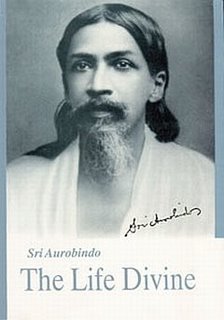 |
Life
In common parlance, ‘life’ as a phenomenal energy is associated with whatever is ‘animate’, whatever breathes and moves, whatever expresses the buoyancy of energy. Indeed it has been eulogized that ‘breath is life’. (One needs to distinguish between the physiological mechanisms of breathing from the “PRANA” or life-force that is the ‘Breath of Life’). Sri Aurobindo however points out like a metaphysician with concomitant scientific precision that:
(a) ‘the spontaneous motion or locomotion , breathing, eating are only processes of life and not life itself’;
(b) ‘processes of our vitality can be maintained in other ways than by our respiration and our means of sustenance. It is a proved fact that even human life can remain in the body and can remain in full consciousness when breathing and the beating of the heart and other conditions formerly deemed essential to it have been temporarily suspended’ (The Life Divine, pg.192); and
(c) The ‘response to stimulus’ which is the ‘proof of vitality’ and if positive points to life while if negative points to death; has been affirmed both in metals as in the plant (Ibid, pg 193).
|
|
Sri Aurobindo refers to the works of the pioneering Indian scientist, Jagadish Chandra Bose. Bose invented the crescograph to measure plant response to various stimuli and demonstrated the parallelism between animal and plant tissues. He also made a comparative study of the fatigue response of various metals and organic tissue in plants. He demonstrated that metals could show ‘fatigue’ like biological cells when confronted with a barrage of mechanical, thermal, chemical and electrical stimuli. His experiments showed cyclical fatigue and recovery response across multiple types of stimuli in both living cells and metals.
Sri Aurobindo takes up this cue of presence of life-energy in plants and metals to demonstrate that consciousness that pervades everything is basically the same with differences in forms, presentations and denouements. ‘But if life , however rudimentary in its symptoms, exists in the metal, it must be admitted as present, involved perhaps or elementary and elemental in the earth or other material existences akin to the metal. If we can pursue our enquiries farther, not obliged to stop short where our immediate means of investigation fail us, we may be sure from our unvarying experience of Nature that investigations thus pursued will in the end prove to us that there is no break, no rigid line of demarcation between the earth and the metal formed in it or between the metal and the plant and, pursuing the synthesis farther, that there is none either between the elements and atoms that constitute the earth or metal and the metal or earth that they constitute. Each step of this graded existence prepares the next, holds in itself what appears in that which follows it. Life is everywhere, secret or manifest, organised or elemental, involved or evolved, but universal, all-pervading, imperishable; only its forms and organisings differ’ (Ibid, pg 193).
This would validate Sri Aurobindo’s own experiential concept of a consciousness that is essentially same throughout though variable in status, nature and poise and that these different denouements are due to the different planes that manifest along the trajectory of an evolving consciousness. Each new plane that evolves is more complex and organized than the prior planes, yet is not disconnected from them but holds them in essence. The creation that is apparently variegated in appearance is integral in essence.
While discovering similarities between his own contentions and the findings of Jagadish Chandra Bose, Sri Aurobindo is cautious not to forcefully equate the conclusions of science and metaphysics as they arise from distinctly separate knowledge-bases; however one cannot deny that certain conclusions of science corroborate certain conclusions of metaphysics. ‘Science cannot dictate its conclusions to metaphysics any more than metaphysics can impose its conclusions on science. Still if we accept the reasonable belief that Being and Nature in all their states have a system of correspondences expressive of a common Truth underlying them, it is permissible to suppose that truths of the physical universe can throw some light on the nature as well as the process of the Force that is active in the universe – not a complete light, for physical Science is necessarily incomplete in the range of its inquiry and has no clue to the occult movements of the Force’ (Ibid, pg 192, footnote).
Date of Update:
25-Jul-17
- By Dr. Soumitra Basu
|

